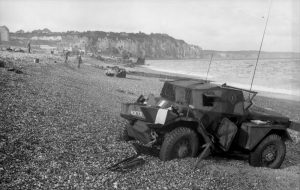Our morning began as we departed from the Hotel Aguado. A light fog rolled across the wet ground as rays of sunlight penetrated the clouds above. Waves crashed along the flint beach while a sea breeze poured in on us. The day prior consisted of a journey through the battles on the beaches of Dieppe. Some of the group members gave presentations on the various assaults and we all left with a very somber feeling as one by one we were given the results of failed attempts at taking a heavily fortified base. Operation Jubilee, as it was code named, ended with over 3000 casualties and very few successes, most of which came from the British commandos. The failure at Dieppe is something that lives in the hearts and minds of Canadians. Never had I felt more grief than I did today as our van approached the Dieppe cemetery. Only a fraction of the soldiers killed on the beach lay here, but the sight was no less overwhelming. My heart sank as I looked across the rows upon rows of graves etched with the maple leaf. We slowly dispersed among the ranks of the fallen. This was a young person’s war. Those who died were largely in their twenties or younger. I found myself passing the time while reading the epitaphs on each of the grave stones. Inscribed were incredibly sad messages. The tone of glorious victory on the inscriptions on the headstones from the First World War had been replaced by a taste of sobriety. The realities of war and the cost of human life are fully realized. “All you had you gave, to save mankind, yourself you scorned to save” and “When days are dark and friends are few dear George I long for you. His loving wife and son” are only a portion of what I saw. The inscriptions were like daggers, each more poignant and emotional than the last until finally I felt it. “The beloved son of Mr. and Mrs. Cyrus Stuart Hall’s Harbour. King’s Country. Nova Scotia,” was printed just below “K. M. Stuart, age 19.” A boy just younger than myself occupies nothing more than a plot of land and the space in his parents’ memories. And that’s war. Tears welled in my eyes as we moved to our next destination. I will never forget Dieppe.
Our next stops were much less emotional. Almost dramatically so. Dieppe was emotionally draining. The emptiness persisted as we drove from Dieppe to Normandy to experience the famed campaign that allowed the Allies to liberate France from Nazi Germany. We began at the crossroads, where the First Canadian Airborne had been deployed on June 6, 1944. On that day, the Canadians had landed very dispersed. Their plan to invade ended up being severely undermanned but the men managed to hold their objective until the allied support broke through. We also found that our country’s flag was missing from the monument so, like a typical group of proud Canadians, we replaced it with a Canadian flag of our own that was much larger than those it flew next to. We had achieved clear aerial superiority. After our duty was completed, we headed to the famed Pegasus bridge. What I saw shocked me. Being that it was two days to the anniversary of D-day, tourists were piling into Normandy to celebrate what the allies had accomplished years ago. I hadn’t expected so much commotion. They had an excellent museum here that I felt properly commemorated the accomplishment of the airborne divisions. It was incredible to see the equipment and the environment the men fought with. They were expected to leap from planes and engage the enemy in small squadrons in the dead of night. They had to fight for months at times without receiving support from allied units. The commitment of these brave men to liberating France is incredible.
Before heading to the Moulin Morin to establish a permanent base and rest for the night, we headed to Mulberry Beach. This celebration is what shocked me the most. The battles of the First World War were commemorated in their communities by somber parades. The ceremony at Menin Gate created a melancholy atmosphere, whereas here, at the beach where the allies established a tremendous support line, the feeling was much more triumphant. There were crowds gathered around tacky souvenir shops, sharing ice cream, and enjoying live music. The invasion of Normandy had become a commercialized industry and it was disappointing. The heroes of Normandy and the liberation of France had become a tourist attraction. Their sacrifice and bloodshed has become an opportunity for people to pretend to be soldiers. I was amazed to see children in full battle dress. I only wonder how the Second World War will continue to be commemorated as we move on with arguably the most significant campaign in living memory.
Emilio G. Caputo


